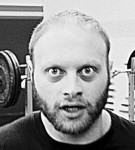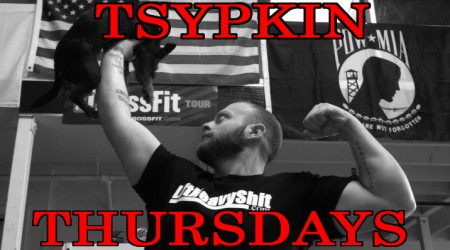Tom O asks, “I have calf pain when squatting ass-to-grass, whether back, front, or overhead. Any ideas what this could be/what I can do about it?”
Could be quite a few things. I’d start with soft tissue and mobility work on the hamstrings, IT band, and calves. Start at the largest crossed joint (hips for hamstrings and IT band, knee for calves) and work down. You may also want to do some compression work around your calves. Finally, address the squat (and the hips) as a whole. Do some range of motion testing (there is a lot of good stuff on Mobility WOD for this) and see where you’re limited. Address those issues and see where it leads. Perhaps of greatest importance, is to remember that dealing with issues like this is not a quick fix, one-and-done kind of deal. It’s going to take some time and patience, but it will pay off.
David H asks, “I’m a new weightlifter and I have long arms. Should I utilize a wide grip on the jerk? I’ve been using a relatively narrow grip and it feels more solid this way, but I can’t help but think I’d benefit from moving my hands out.”
If it ain’t broke, don’t fix it.
Joseph F asks “Box squat for CrossFitters?”
Star Wars action figures for Trekkies?

Harry S asks, “What are some ways to improve my mobility for the snatch? My bottom position looks like a low bar back squat due to tight hips and ankles, and the couch stretch alone isn’t covering it.”
In answering this, I’m going to assume you are already back squatting high bar. If you’re not, fix that, train it for 6 weeks, and see where you’re at. Second, while mobility and stretching is great, I’m a firm believer that the biggest changes are going to happen from doing a lot of the movement you’re trying to improve. Don’t become that guy who spends 2 hours on mobility and 20 minutes lifting (emphasis added by me because this is a glorious statement. – Cloud). With that out of the way, let’s talk about a few excellent drills to help you with this.
1. This one is very specifically helpful for people with your problem: take a length of PVC or broomstick and go into the bottom of your overhead squat. Have someone stand behind you, hands on the PVC, place their knee in your low back, and push your hips forward and down. Be sure to keep your weight on your heels as the knees go forward, and actively push up against the “bar.” Have your helper push down slightly on the PVC – this will help you feel something to push up against.
2. Holding an empty barbell in your hands, squat down and place the bar across your thighs/knees. Push one knee forward at a time (it’s fine to come off your heel) and use the bar to weigh you down at the knee. You should feel a deep stretch around the achilles tendon. Do this a little at a time, switching back and forth between legs, gradually loosening up the tissues and pushing the stretch further.
Barry S asks, “What are the pros and cons of using a percentage based training program for weightlifting?”
This is a big question. I will address it as concisely as possible.
Using percentages can be helpful because it gives you a governor. When done intelligently, in the long term, it can help keep you from doing too much or too little, ensure that you’re mostly working with loads that are beneficial to you, and give you an accurate measurement of the total training load from day to day, week to week, and month to month.
However, they can also be limiting. Is 80% as valuable as 85% or 90%? In my opinion, if you are having a good training day, you’re going to get more out of taking the weight up and working heavier than just sticking to a set number. And it’s always good to have the opportunity to strike when the iron is hot and set new PRs.
This is not to say that a percentage based program can’t work. There are obviously a lot of great lifters and coaches who use percentages. And I think they can be useful for someone who is training alone, to mitigate burnout and keep the lifter from getting to the point where they’re so exhausted that they are no longer able to recognize and correct mistakes.
Dave F asks, “If you were to design a program for someone looking to compete in both weightlifting and powerlifting, what would you emphasize?”
This is another big question, not one I can address effectively within the scope of this post. But I will say this: I very strongly believe that in order to be successful at both weightlifting and powerlifting, one would need to emphasize weightlifting as the main discipline. The short version of the long answer to the question “why?” is this: weightlifting has the potential to improve you as a powerlifter far more than powerlifting has the potential to improve you as a weightlifter. There is already great importance placed on squatting and pulling strength, and the bench press can be treated as a supplementary exercise for a large part of the year. I would, obviously, shift emphasis closer to a powerlifting meet for the final preparatory period.
 Jacob Tsypkin is a CrossFit and weightlifting coach, the co-owner of CrossFit Monterey and the Monterey Bay Barbell Club in Monterey, CA. He is available for weightlifting seminars and already has a perfect score on 13.4.
Jacob Tsypkin is a CrossFit and weightlifting coach, the co-owner of CrossFit Monterey and the Monterey Bay Barbell Club in Monterey, CA. He is available for weightlifting seminars and already has a perfect score on 13.4.


The Darth Vader pic is strong af
Just when Yakof could sense he was losing the non-weighlifters in the crowd, he pulls out that gem and reels us back in.
Come to the Dark Side. We has lulz.
For the last question: Pendlay did a write up on this a while ago. I’m planning on following the program for at least 2 months to see how I do.
http://www.pendlay.com/Training-for-the-Supertotal_df_89.html
In response to Tom O’s question about calf pain. I had a similar issue, mine was pain high on the outside of my right calf, where the back of the knee and calf meet almost and the pain went downwards. I did what Tsypkin has advised and foam rolled the shit out of my hips, hamstrings, IT band and then calves and after about a week and a half the pain subsided greatly. My issue after watching some video was my knees collapsing on heavy squats and coming inward. I’ve since corrected this and my pain is nearly gone.
On the mobbin’ theme, what are y’all’s favorite groin & adductor mobs? Especially for the high/approaching-the-scrotch zone? I have brutal tightness there from all the low-bar squats, but it’s a tough area get into with a foam roller or lax ball.
also, inb4 “manual release.”
Ummm .. do you even MopeWOD? Episode 1, brah.
http://www.youtube.com/watch?v=AIdpcx6RWjU
(Supafriend required)
props to the Vader pic
Calf PAIN or just soreness? I always feel it in my calves after heavy (back) squats, and after heavy C&J… but I’ve found I’m not alone. Not pain, though, just… soreness.
PSOAS, people. Get someone to dig in to those, and your squat mobility will be on another level. Seriously. I wasn’t a believer until my buddy dug in, I cried, I screamed… I squatted way better.
As for WL/PL combo, I am guilty of this. I’m a weightlifter, but every now and then I like to compete in PL just for kicks, and the only difference I do is about a month out of the meet I switch my squats to low bar sets instead of high bar, and add in some bench as supplemental exercises (I find as a girl this will never hinder my mobility, but instead significantly helps my snatch), and 2 weeks out I do some deadlifts, at least up to my intended opener weight. The strength is there, it’s more a matter of remembering how to do it.
Cannot stop laughing at that darth vader pic
Justin, this used to be an awesome site for lifters… now, with things like this and defending the crossfitters and their bouncelifts, it is starting to become like any other site about fitness… hopefully, you’ll go back to what IS 70sbig
Yeah man.
This post answering questions about a fairly common issue with calf pain when squatting deep, how to go about training for weightlifting and powerlifting, and whether a percentage based program is of use or not is stupid and has nothing to do with lifting heavy.
I mean honestly, why on earth would a site about lifting do a Q&A with an experienced weightlifting and powerlifting coach?
Makes no sense dude. I’m going back to Reddit.
Dear Big J,
My dad is about to get hip replacement surgery, because he has run out of cartilage in his right hip.
He was advised to build muscle around his hip ahead of time (around 8 weeks till surgery now) and asked me for help.
He has limited ROM and is not particularly strong, but is in ok shape for a 67 year old, he’ll hike 12 miles and climbs with me.
So far I have him rowing for gluteal stimulation, and adding an avocado to his breakfast (he eats ok, could do with more).
Do you have any recommendations for a guy with limited hip rom before he gets sliced and diced please?
Thanks, Owen
Also, banging a load of NSAIDs and working through hip pain is acceptable; he’s a hard old bastard. I’d prefer not to if there’s a smarter way though.